Entrepreneurship and Innovation - Transportation
VerifiedAdded on 2022/09/02
|10
|2755
|18
AI Summary
Contribute Materials
Your contribution can guide someone’s learning journey. Share your
documents today.
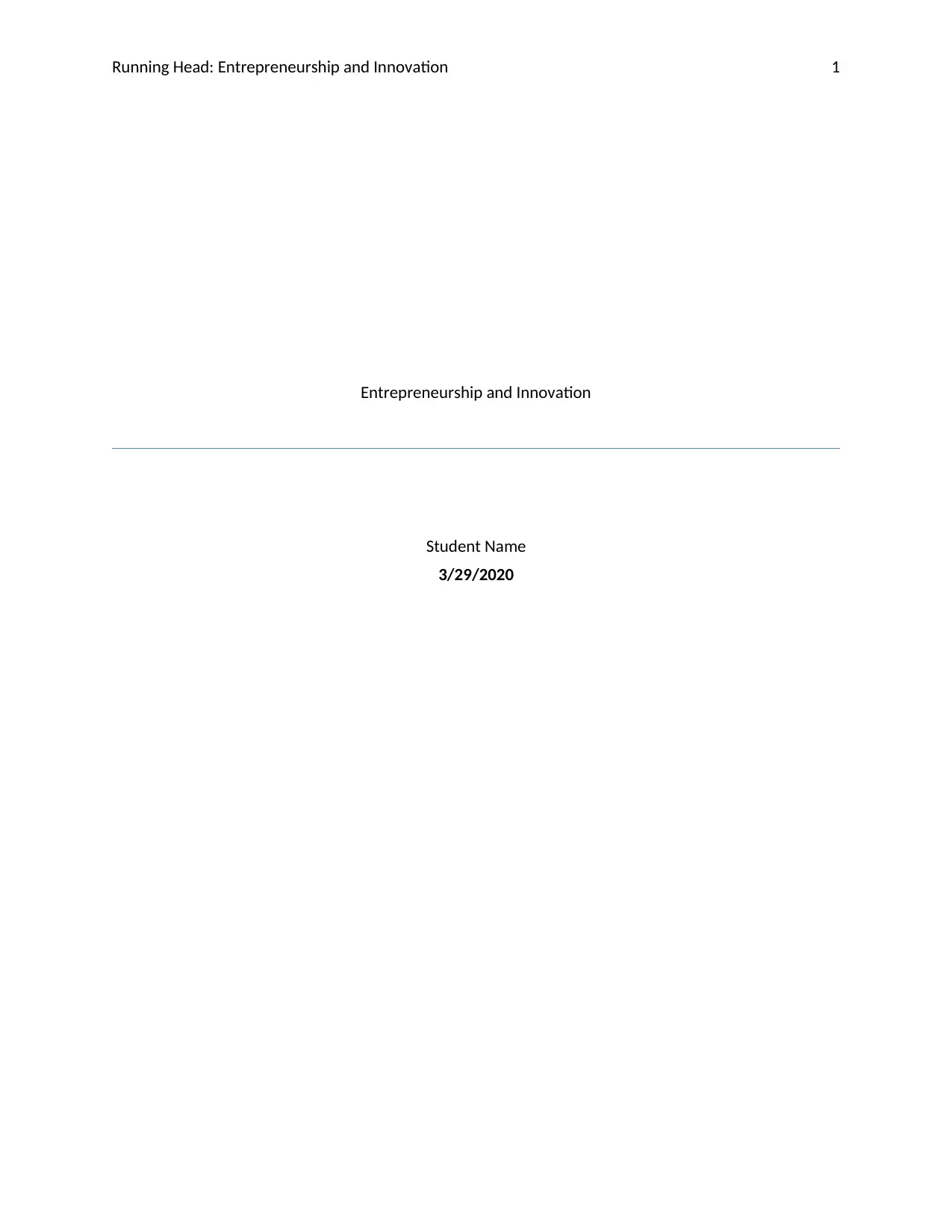
Running Head: Entrepreneurship and Innovation 1
Entrepreneurship and Innovation
Student Name
3/29/2020
Entrepreneurship and Innovation
Student Name
3/29/2020
Secure Best Marks with AI Grader
Need help grading? Try our AI Grader for instant feedback on your assignments.

Running Head: Entrepreneurship and Innovation 2
Executive Summary
The climate is growing in importance to people around the world. Throughout both the
business and scholarly literature, sustainability has become a mantra. People are aware of the
negative consequences of emissions and the fact that transport adds greatly to the atmosphere.
Transportation is the world's second biggest pollution source. Therefore, one of the leading
companies Tesla has entered in the market with electronic vehicle. It is one of the inventions that
were introduced by the company to make sustainable environment. Electric vehicle market is
increasing day by day that enhances the level of competition in the market. The key players are
BMW, Tesla, Nissan, and Toyota. However, the company has also faced certain challenges
which include managing battery life of electric car that affected over the sales of the company to
the certain extent. The company raised its funds through borrowing it from the bank as well as by
issuing bonds that help them to focus over the market in more effective manner. Overall the
company manages its business in an effective manner that made them leading in the global
market.
Executive Summary
The climate is growing in importance to people around the world. Throughout both the
business and scholarly literature, sustainability has become a mantra. People are aware of the
negative consequences of emissions and the fact that transport adds greatly to the atmosphere.
Transportation is the world's second biggest pollution source. Therefore, one of the leading
companies Tesla has entered in the market with electronic vehicle. It is one of the inventions that
were introduced by the company to make sustainable environment. Electric vehicle market is
increasing day by day that enhances the level of competition in the market. The key players are
BMW, Tesla, Nissan, and Toyota. However, the company has also faced certain challenges
which include managing battery life of electric car that affected over the sales of the company to
the certain extent. The company raised its funds through borrowing it from the bank as well as by
issuing bonds that help them to focus over the market in more effective manner. Overall the
company manages its business in an effective manner that made them leading in the global
market.
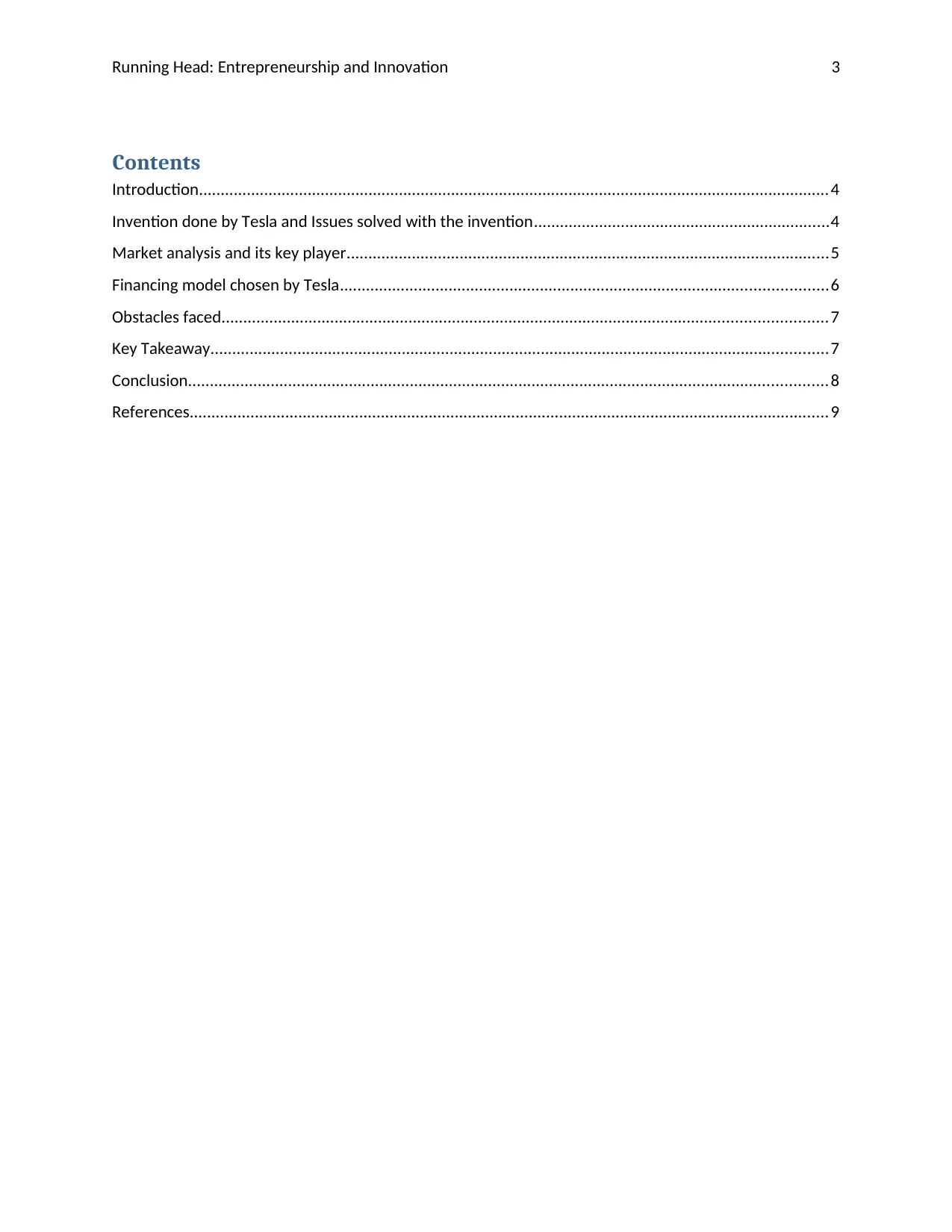
Running Head: Entrepreneurship and Innovation 3
Contents
Introduction.................................................................................................................................................4
Invention done by Tesla and Issues solved with the invention....................................................................4
Market analysis and its key player...............................................................................................................5
Financing model chosen by Tesla................................................................................................................6
Obstacles faced...........................................................................................................................................7
Key Takeaway..............................................................................................................................................7
Conclusion...................................................................................................................................................8
References...................................................................................................................................................9
Contents
Introduction.................................................................................................................................................4
Invention done by Tesla and Issues solved with the invention....................................................................4
Market analysis and its key player...............................................................................................................5
Financing model chosen by Tesla................................................................................................................6
Obstacles faced...........................................................................................................................................7
Key Takeaway..............................................................................................................................................7
Conclusion...................................................................................................................................................8
References...................................................................................................................................................9
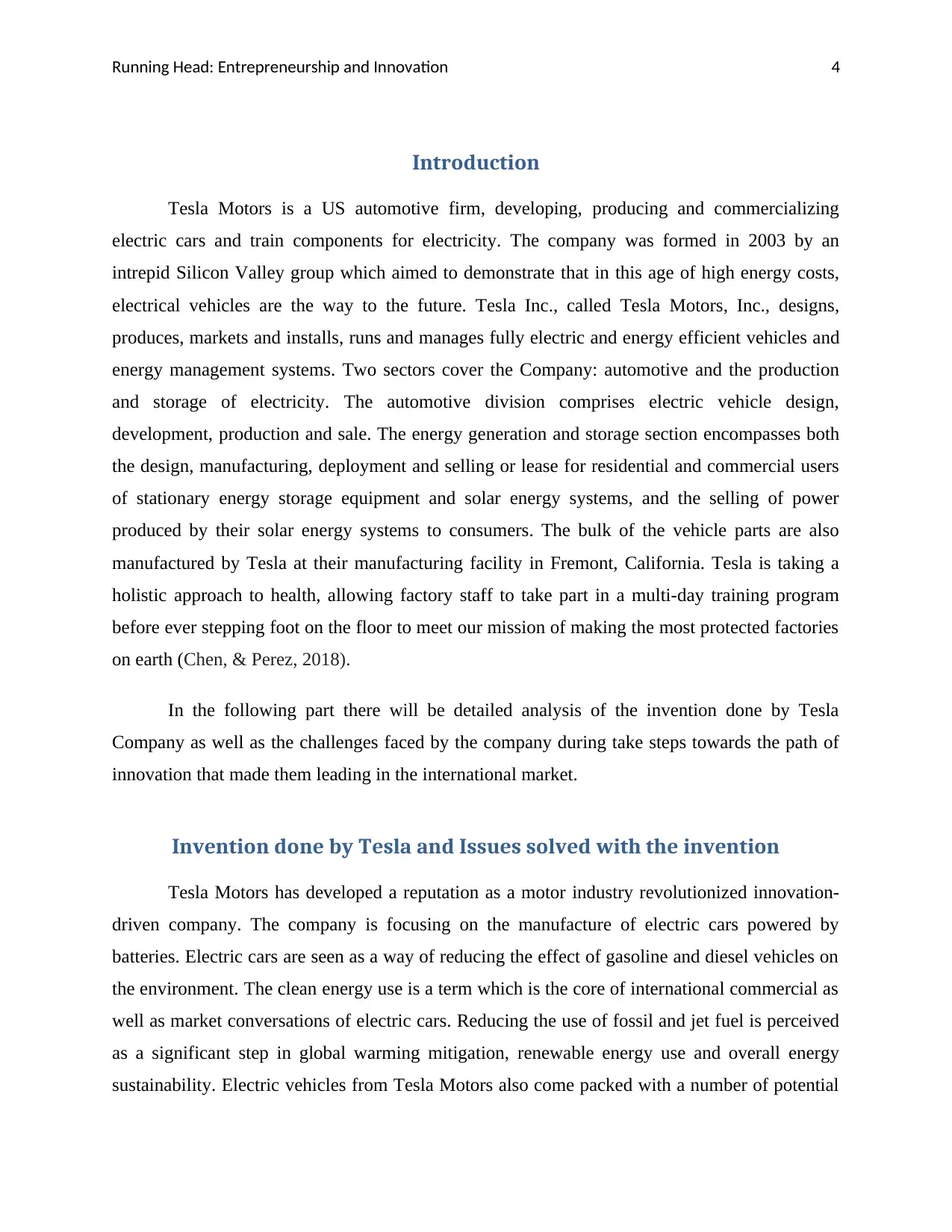
Running Head: Entrepreneurship and Innovation 4
Introduction
Tesla Motors is a US automotive firm, developing, producing and commercializing
electric cars and train components for electricity. The company was formed in 2003 by an
intrepid Silicon Valley group which aimed to demonstrate that in this age of high energy costs,
electrical vehicles are the way to the future. Tesla Inc., called Tesla Motors, Inc., designs,
produces, markets and installs, runs and manages fully electric and energy efficient vehicles and
energy management systems. Two sectors cover the Company: automotive and the production
and storage of electricity. The automotive division comprises electric vehicle design,
development, production and sale. The energy generation and storage section encompasses both
the design, manufacturing, deployment and selling or lease for residential and commercial users
of stationary energy storage equipment and solar energy systems, and the selling of power
produced by their solar energy systems to consumers. The bulk of the vehicle parts are also
manufactured by Tesla at their manufacturing facility in Fremont, California. Tesla is taking a
holistic approach to health, allowing factory staff to take part in a multi-day training program
before ever stepping foot on the floor to meet our mission of making the most protected factories
on earth (Chen, & Perez, 2018).
In the following part there will be detailed analysis of the invention done by Tesla
Company as well as the challenges faced by the company during take steps towards the path of
innovation that made them leading in the international market.
Invention done by Tesla and Issues solved with the invention
Tesla Motors has developed a reputation as a motor industry revolutionized innovation-
driven company. The company is focusing on the manufacture of electric cars powered by
batteries. Electric cars are seen as a way of reducing the effect of gasoline and diesel vehicles on
the environment. The clean energy use is a term which is the core of international commercial as
well as market conversations of electric cars. Reducing the use of fossil and jet fuel is perceived
as a significant step in global warming mitigation, renewable energy use and overall energy
sustainability. Electric vehicles from Tesla Motors also come packed with a number of potential
Introduction
Tesla Motors is a US automotive firm, developing, producing and commercializing
electric cars and train components for electricity. The company was formed in 2003 by an
intrepid Silicon Valley group which aimed to demonstrate that in this age of high energy costs,
electrical vehicles are the way to the future. Tesla Inc., called Tesla Motors, Inc., designs,
produces, markets and installs, runs and manages fully electric and energy efficient vehicles and
energy management systems. Two sectors cover the Company: automotive and the production
and storage of electricity. The automotive division comprises electric vehicle design,
development, production and sale. The energy generation and storage section encompasses both
the design, manufacturing, deployment and selling or lease for residential and commercial users
of stationary energy storage equipment and solar energy systems, and the selling of power
produced by their solar energy systems to consumers. The bulk of the vehicle parts are also
manufactured by Tesla at their manufacturing facility in Fremont, California. Tesla is taking a
holistic approach to health, allowing factory staff to take part in a multi-day training program
before ever stepping foot on the floor to meet our mission of making the most protected factories
on earth (Chen, & Perez, 2018).
In the following part there will be detailed analysis of the invention done by Tesla
Company as well as the challenges faced by the company during take steps towards the path of
innovation that made them leading in the international market.
Invention done by Tesla and Issues solved with the invention
Tesla Motors has developed a reputation as a motor industry revolutionized innovation-
driven company. The company is focusing on the manufacture of electric cars powered by
batteries. Electric cars are seen as a way of reducing the effect of gasoline and diesel vehicles on
the environment. The clean energy use is a term which is the core of international commercial as
well as market conversations of electric cars. Reducing the use of fossil and jet fuel is perceived
as a significant step in global warming mitigation, renewable energy use and overall energy
sustainability. Electric vehicles from Tesla Motors also come packed with a number of potential
Secure Best Marks with AI Grader
Need help grading? Try our AI Grader for instant feedback on your assignments.
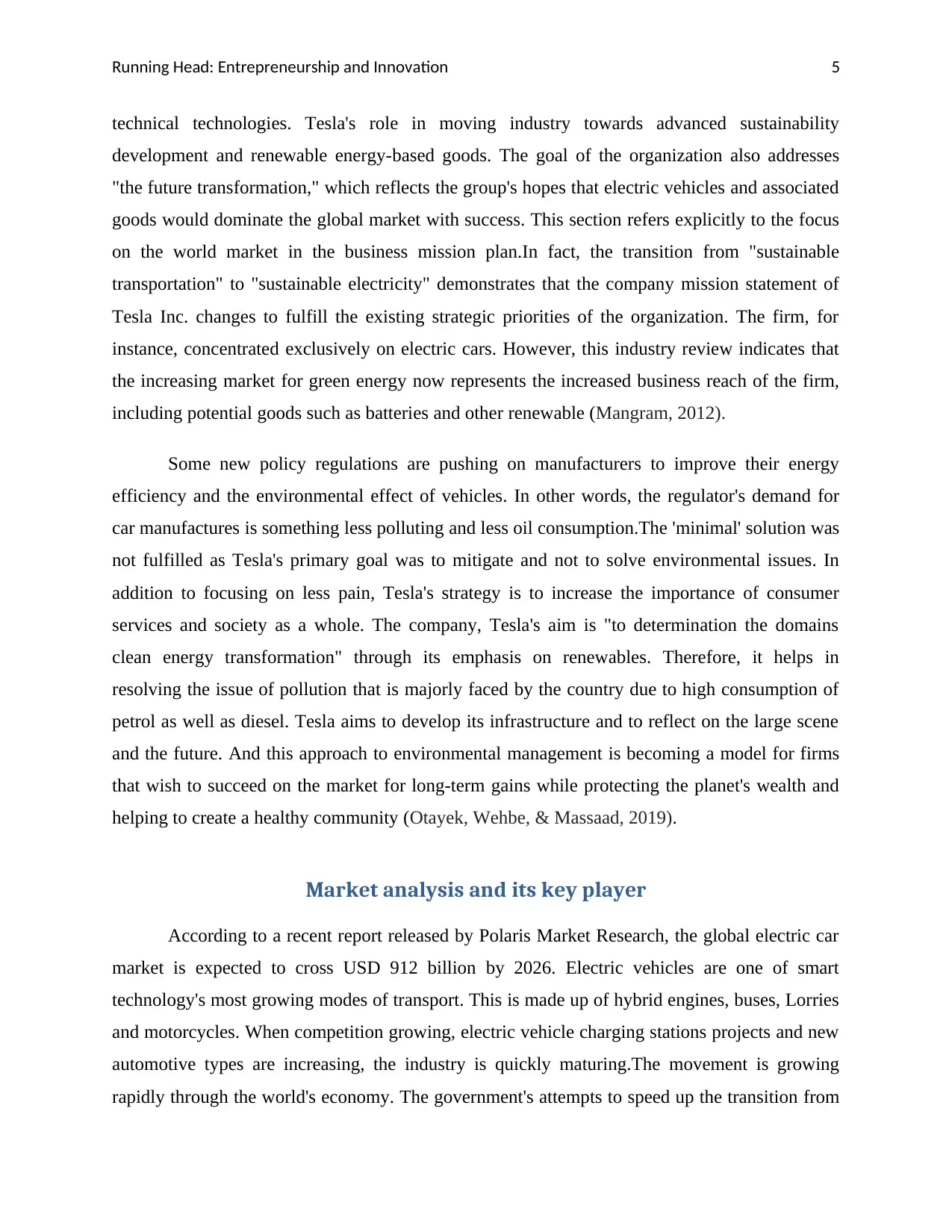
Running Head: Entrepreneurship and Innovation 5
technical technologies. Tesla's role in moving industry towards advanced sustainability
development and renewable energy-based goods. The goal of the organization also addresses
"the future transformation," which reflects the group's hopes that electric vehicles and associated
goods would dominate the global market with success. This section refers explicitly to the focus
on the world market in the business mission plan.In fact, the transition from "sustainable
transportation" to "sustainable electricity" demonstrates that the company mission statement of
Tesla Inc. changes to fulfill the existing strategic priorities of the organization. The firm, for
instance, concentrated exclusively on electric cars. However, this industry review indicates that
the increasing market for green energy now represents the increased business reach of the firm,
including potential goods such as batteries and other renewable (Mangram, 2012).
Some new policy regulations are pushing on manufacturers to improve their energy
efficiency and the environmental effect of vehicles. In other words, the regulator's demand for
car manufactures is something less polluting and less oil consumption.The 'minimal' solution was
not fulfilled as Tesla's primary goal was to mitigate and not to solve environmental issues. In
addition to focusing on less pain, Tesla's strategy is to increase the importance of consumer
services and society as a whole. The company, Tesla's aim is "to determination the domains
clean energy transformation" through its emphasis on renewables. Therefore, it helps in
resolving the issue of pollution that is majorly faced by the country due to high consumption of
petrol as well as diesel. Tesla aims to develop its infrastructure and to reflect on the large scene
and the future. And this approach to environmental management is becoming a model for firms
that wish to succeed on the market for long-term gains while protecting the planet's wealth and
helping to create a healthy community (Otayek, Wehbe, & Massaad, 2019).
Market analysis and its key player
According to a recent report released by Polaris Market Research, the global electric car
market is expected to cross USD 912 billion by 2026. Electric vehicles are one of smart
technology's most growing modes of transport. This is made up of hybrid engines, buses, Lorries
and motorcycles. When competition growing, electric vehicle charging stations projects and new
automotive types are increasing, the industry is quickly maturing.The movement is growing
rapidly through the world's economy. The government's attempts to speed up the transition from
technical technologies. Tesla's role in moving industry towards advanced sustainability
development and renewable energy-based goods. The goal of the organization also addresses
"the future transformation," which reflects the group's hopes that electric vehicles and associated
goods would dominate the global market with success. This section refers explicitly to the focus
on the world market in the business mission plan.In fact, the transition from "sustainable
transportation" to "sustainable electricity" demonstrates that the company mission statement of
Tesla Inc. changes to fulfill the existing strategic priorities of the organization. The firm, for
instance, concentrated exclusively on electric cars. However, this industry review indicates that
the increasing market for green energy now represents the increased business reach of the firm,
including potential goods such as batteries and other renewable (Mangram, 2012).
Some new policy regulations are pushing on manufacturers to improve their energy
efficiency and the environmental effect of vehicles. In other words, the regulator's demand for
car manufactures is something less polluting and less oil consumption.The 'minimal' solution was
not fulfilled as Tesla's primary goal was to mitigate and not to solve environmental issues. In
addition to focusing on less pain, Tesla's strategy is to increase the importance of consumer
services and society as a whole. The company, Tesla's aim is "to determination the domains
clean energy transformation" through its emphasis on renewables. Therefore, it helps in
resolving the issue of pollution that is majorly faced by the country due to high consumption of
petrol as well as diesel. Tesla aims to develop its infrastructure and to reflect on the large scene
and the future. And this approach to environmental management is becoming a model for firms
that wish to succeed on the market for long-term gains while protecting the planet's wealth and
helping to create a healthy community (Otayek, Wehbe, & Massaad, 2019).
Market analysis and its key player
According to a recent report released by Polaris Market Research, the global electric car
market is expected to cross USD 912 billion by 2026. Electric vehicles are one of smart
technology's most growing modes of transport. This is made up of hybrid engines, buses, Lorries
and motorcycles. When competition growing, electric vehicle charging stations projects and new
automotive types are increasing, the industry is quickly maturing.The movement is growing
rapidly through the world's economy. The government's attempts to speed up the transition from
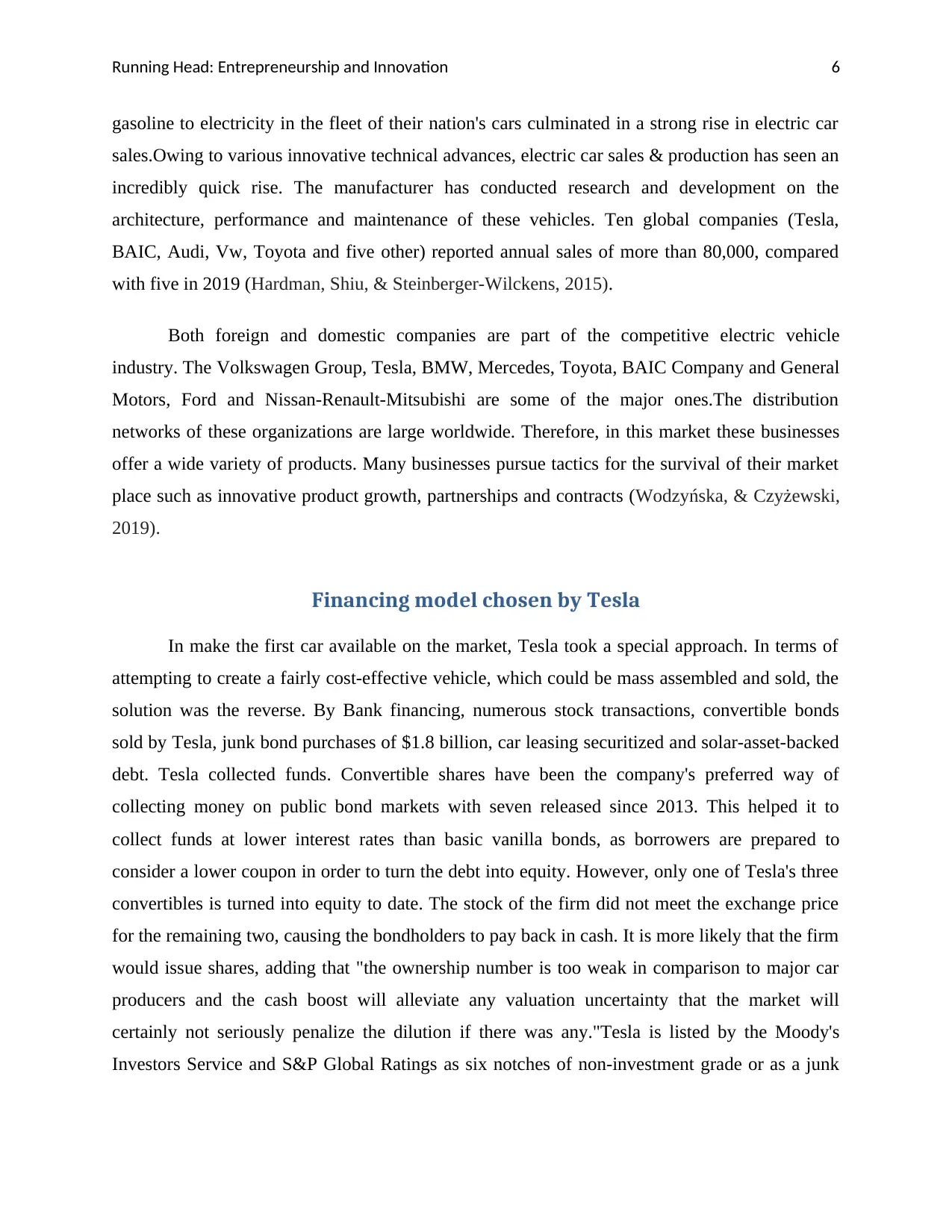
Running Head: Entrepreneurship and Innovation 6
gasoline to electricity in the fleet of their nation's cars culminated in a strong rise in electric car
sales.Owing to various innovative technical advances, electric car sales & production has seen an
incredibly quick rise. The manufacturer has conducted research and development on the
architecture, performance and maintenance of these vehicles. Ten global companies (Tesla,
BAIC, Audi, Vw, Toyota and five other) reported annual sales of more than 80,000, compared
with five in 2019 (Hardman, Shiu, & Steinberger-Wilckens, 2015).
Both foreign and domestic companies are part of the competitive electric vehicle
industry. The Volkswagen Group, Tesla, BMW, Mercedes, Toyota, BAIC Company and General
Motors, Ford and Nissan-Renault-Mitsubishi are some of the major ones.The distribution
networks of these organizations are large worldwide. Therefore, in this market these businesses
offer a wide variety of products. Many businesses pursue tactics for the survival of their market
place such as innovative product growth, partnerships and contracts (Wodzyńska, & Czyżewski,
2019).
Financing model chosen by Tesla
In make the first car available on the market, Tesla took a special approach. In terms of
attempting to create a fairly cost-effective vehicle, which could be mass assembled and sold, the
solution was the reverse. By Bank financing, numerous stock transactions, convertible bonds
sold by Tesla, junk bond purchases of $1.8 billion, car leasing securitized and solar-asset-backed
debt. Tesla collected funds. Convertible shares have been the company's preferred way of
collecting money on public bond markets with seven released since 2013. This helped it to
collect funds at lower interest rates than basic vanilla bonds, as borrowers are prepared to
consider a lower coupon in order to turn the debt into equity. However, only one of Tesla's three
convertibles is turned into equity to date. The stock of the firm did not meet the exchange price
for the remaining two, causing the bondholders to pay back in cash. It is more likely that the firm
would issue shares, adding that "the ownership number is too weak in comparison to major car
producers and the cash boost will alleviate any valuation uncertainty that the market will
certainly not seriously penalize the dilution if there was any."Tesla is listed by the Moody's
Investors Service and S&P Global Ratings as six notches of non-investment grade or as a junk
gasoline to electricity in the fleet of their nation's cars culminated in a strong rise in electric car
sales.Owing to various innovative technical advances, electric car sales & production has seen an
incredibly quick rise. The manufacturer has conducted research and development on the
architecture, performance and maintenance of these vehicles. Ten global companies (Tesla,
BAIC, Audi, Vw, Toyota and five other) reported annual sales of more than 80,000, compared
with five in 2019 (Hardman, Shiu, & Steinberger-Wilckens, 2015).
Both foreign and domestic companies are part of the competitive electric vehicle
industry. The Volkswagen Group, Tesla, BMW, Mercedes, Toyota, BAIC Company and General
Motors, Ford and Nissan-Renault-Mitsubishi are some of the major ones.The distribution
networks of these organizations are large worldwide. Therefore, in this market these businesses
offer a wide variety of products. Many businesses pursue tactics for the survival of their market
place such as innovative product growth, partnerships and contracts (Wodzyńska, & Czyżewski,
2019).
Financing model chosen by Tesla
In make the first car available on the market, Tesla took a special approach. In terms of
attempting to create a fairly cost-effective vehicle, which could be mass assembled and sold, the
solution was the reverse. By Bank financing, numerous stock transactions, convertible bonds
sold by Tesla, junk bond purchases of $1.8 billion, car leasing securitized and solar-asset-backed
debt. Tesla collected funds. Convertible shares have been the company's preferred way of
collecting money on public bond markets with seven released since 2013. This helped it to
collect funds at lower interest rates than basic vanilla bonds, as borrowers are prepared to
consider a lower coupon in order to turn the debt into equity. However, only one of Tesla's three
convertibles is turned into equity to date. The stock of the firm did not meet the exchange price
for the remaining two, causing the bondholders to pay back in cash. It is more likely that the firm
would issue shares, adding that "the ownership number is too weak in comparison to major car
producers and the cash boost will alleviate any valuation uncertainty that the market will
certainly not seriously penalize the dilution if there was any."Tesla is listed by the Moody's
Investors Service and S&P Global Ratings as six notches of non-investment grade or as a junk
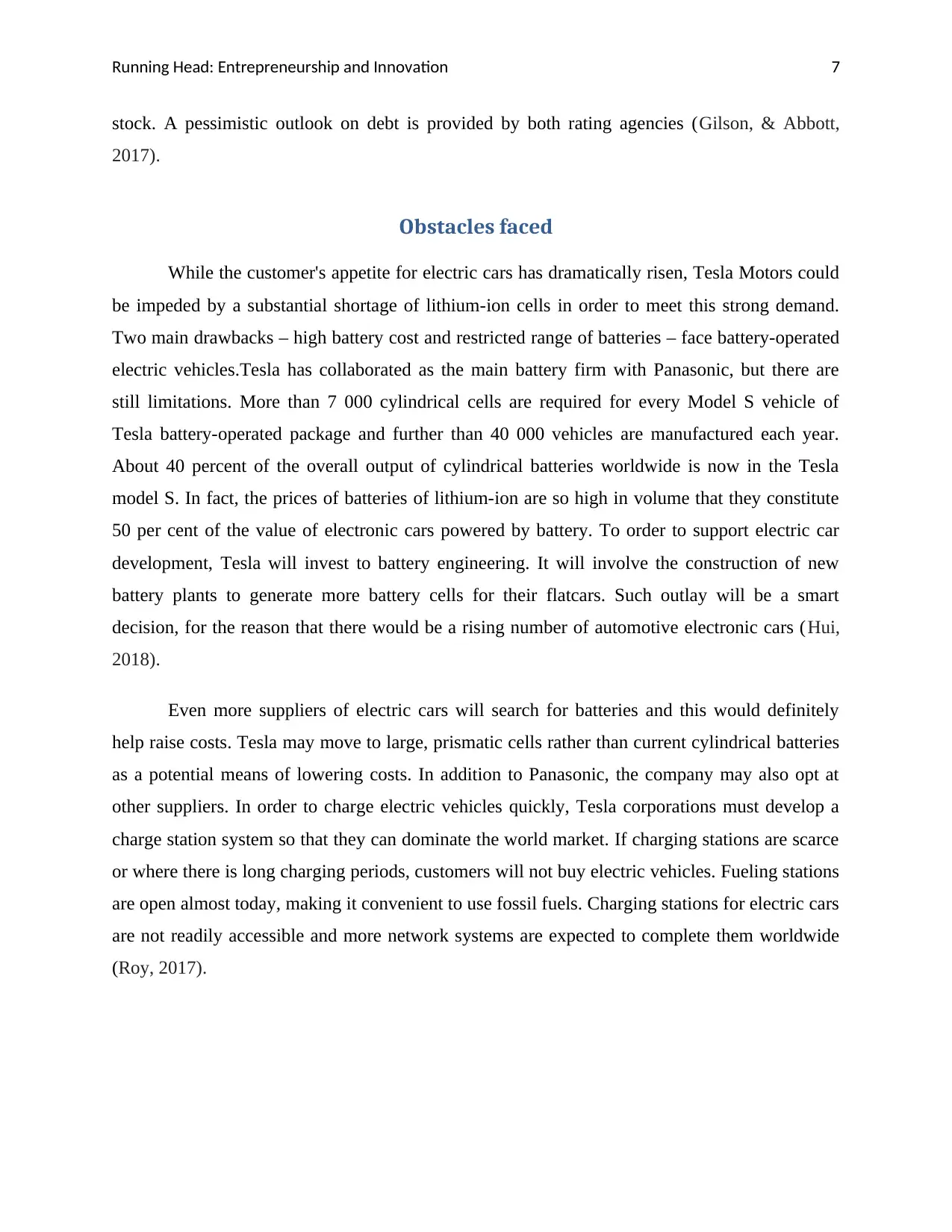
Running Head: Entrepreneurship and Innovation 7
stock. A pessimistic outlook on debt is provided by both rating agencies (Gilson, & Abbott,
2017).
Obstacles faced
While the customer's appetite for electric cars has dramatically risen, Tesla Motors could
be impeded by a substantial shortage of lithium-ion cells in order to meet this strong demand.
Two main drawbacks – high battery cost and restricted range of batteries – face battery-operated
electric vehicles.Tesla has collaborated as the main battery firm with Panasonic, but there are
still limitations. More than 7 000 cylindrical cells are required for every Model S vehicle of
Tesla battery-operated package and further than 40 000 vehicles are manufactured each year.
About 40 percent of the overall output of cylindrical batteries worldwide is now in the Tesla
model S. In fact, the prices of batteries of lithium-ion are so high in volume that they constitute
50 per cent of the value of electronic cars powered by battery. To order to support electric car
development, Tesla will invest to battery engineering. It will involve the construction of new
battery plants to generate more battery cells for their flatcars. Such outlay will be a smart
decision, for the reason that there would be a rising number of automotive electronic cars (Hui,
2018).
Even more suppliers of electric cars will search for batteries and this would definitely
help raise costs. Tesla may move to large, prismatic cells rather than current cylindrical batteries
as a potential means of lowering costs. In addition to Panasonic, the company may also opt at
other suppliers. In order to charge electric vehicles quickly, Tesla corporations must develop a
charge station system so that they can dominate the world market. If charging stations are scarce
or where there is long charging periods, customers will not buy electric vehicles. Fueling stations
are open almost today, making it convenient to use fossil fuels. Charging stations for electric cars
are not readily accessible and more network systems are expected to complete them worldwide
(Roy, 2017).
stock. A pessimistic outlook on debt is provided by both rating agencies (Gilson, & Abbott,
2017).
Obstacles faced
While the customer's appetite for electric cars has dramatically risen, Tesla Motors could
be impeded by a substantial shortage of lithium-ion cells in order to meet this strong demand.
Two main drawbacks – high battery cost and restricted range of batteries – face battery-operated
electric vehicles.Tesla has collaborated as the main battery firm with Panasonic, but there are
still limitations. More than 7 000 cylindrical cells are required for every Model S vehicle of
Tesla battery-operated package and further than 40 000 vehicles are manufactured each year.
About 40 percent of the overall output of cylindrical batteries worldwide is now in the Tesla
model S. In fact, the prices of batteries of lithium-ion are so high in volume that they constitute
50 per cent of the value of electronic cars powered by battery. To order to support electric car
development, Tesla will invest to battery engineering. It will involve the construction of new
battery plants to generate more battery cells for their flatcars. Such outlay will be a smart
decision, for the reason that there would be a rising number of automotive electronic cars (Hui,
2018).
Even more suppliers of electric cars will search for batteries and this would definitely
help raise costs. Tesla may move to large, prismatic cells rather than current cylindrical batteries
as a potential means of lowering costs. In addition to Panasonic, the company may also opt at
other suppliers. In order to charge electric vehicles quickly, Tesla corporations must develop a
charge station system so that they can dominate the world market. If charging stations are scarce
or where there is long charging periods, customers will not buy electric vehicles. Fueling stations
are open almost today, making it convenient to use fossil fuels. Charging stations for electric cars
are not readily accessible and more network systems are expected to complete them worldwide
(Roy, 2017).
Paraphrase This Document
Need a fresh take? Get an instant paraphrase of this document with our AI Paraphraser
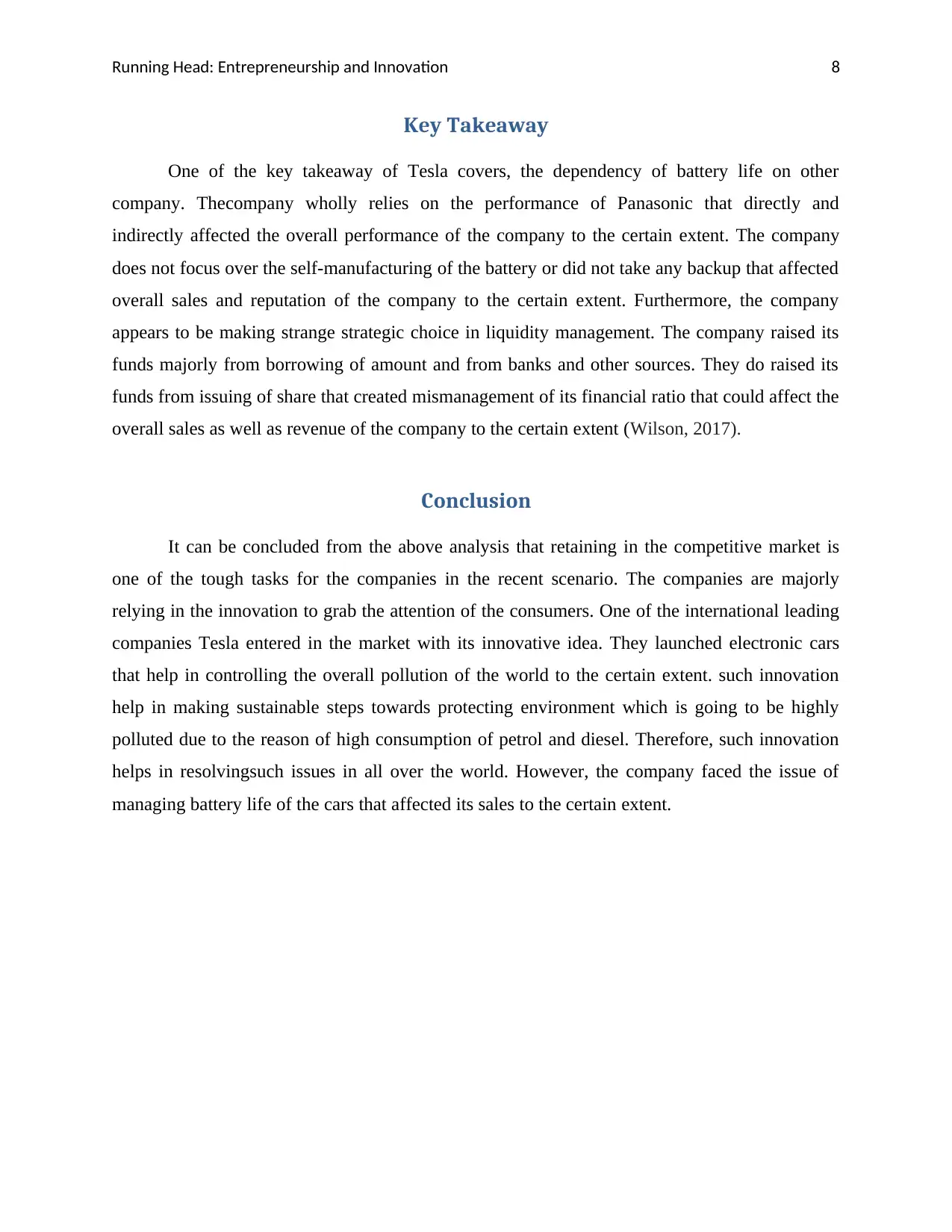
Running Head: Entrepreneurship and Innovation 8
Key Takeaway
One of the key takeaway of Tesla covers, the dependency of battery life on other
company. Thecompany wholly relies on the performance of Panasonic that directly and
indirectly affected the overall performance of the company to the certain extent. The company
does not focus over the self-manufacturing of the battery or did not take any backup that affected
overall sales and reputation of the company to the certain extent. Furthermore, the company
appears to be making strange strategic choice in liquidity management. The company raised its
funds majorly from borrowing of amount and from banks and other sources. They do raised its
funds from issuing of share that created mismanagement of its financial ratio that could affect the
overall sales as well as revenue of the company to the certain extent (Wilson, 2017).
Conclusion
It can be concluded from the above analysis that retaining in the competitive market is
one of the tough tasks for the companies in the recent scenario. The companies are majorly
relying in the innovation to grab the attention of the consumers. One of the international leading
companies Tesla entered in the market with its innovative idea. They launched electronic cars
that help in controlling the overall pollution of the world to the certain extent. such innovation
help in making sustainable steps towards protecting environment which is going to be highly
polluted due to the reason of high consumption of petrol and diesel. Therefore, such innovation
helps in resolvingsuch issues in all over the world. However, the company faced the issue of
managing battery life of the cars that affected its sales to the certain extent.
Key Takeaway
One of the key takeaway of Tesla covers, the dependency of battery life on other
company. Thecompany wholly relies on the performance of Panasonic that directly and
indirectly affected the overall performance of the company to the certain extent. The company
does not focus over the self-manufacturing of the battery or did not take any backup that affected
overall sales and reputation of the company to the certain extent. Furthermore, the company
appears to be making strange strategic choice in liquidity management. The company raised its
funds majorly from borrowing of amount and from banks and other sources. They do raised its
funds from issuing of share that created mismanagement of its financial ratio that could affect the
overall sales as well as revenue of the company to the certain extent (Wilson, 2017).
Conclusion
It can be concluded from the above analysis that retaining in the competitive market is
one of the tough tasks for the companies in the recent scenario. The companies are majorly
relying in the innovation to grab the attention of the consumers. One of the international leading
companies Tesla entered in the market with its innovative idea. They launched electronic cars
that help in controlling the overall pollution of the world to the certain extent. such innovation
help in making sustainable steps towards protecting environment which is going to be highly
polluted due to the reason of high consumption of petrol and diesel. Therefore, such innovation
helps in resolvingsuch issues in all over the world. However, the company faced the issue of
managing battery life of the cars that affected its sales to the certain extent.
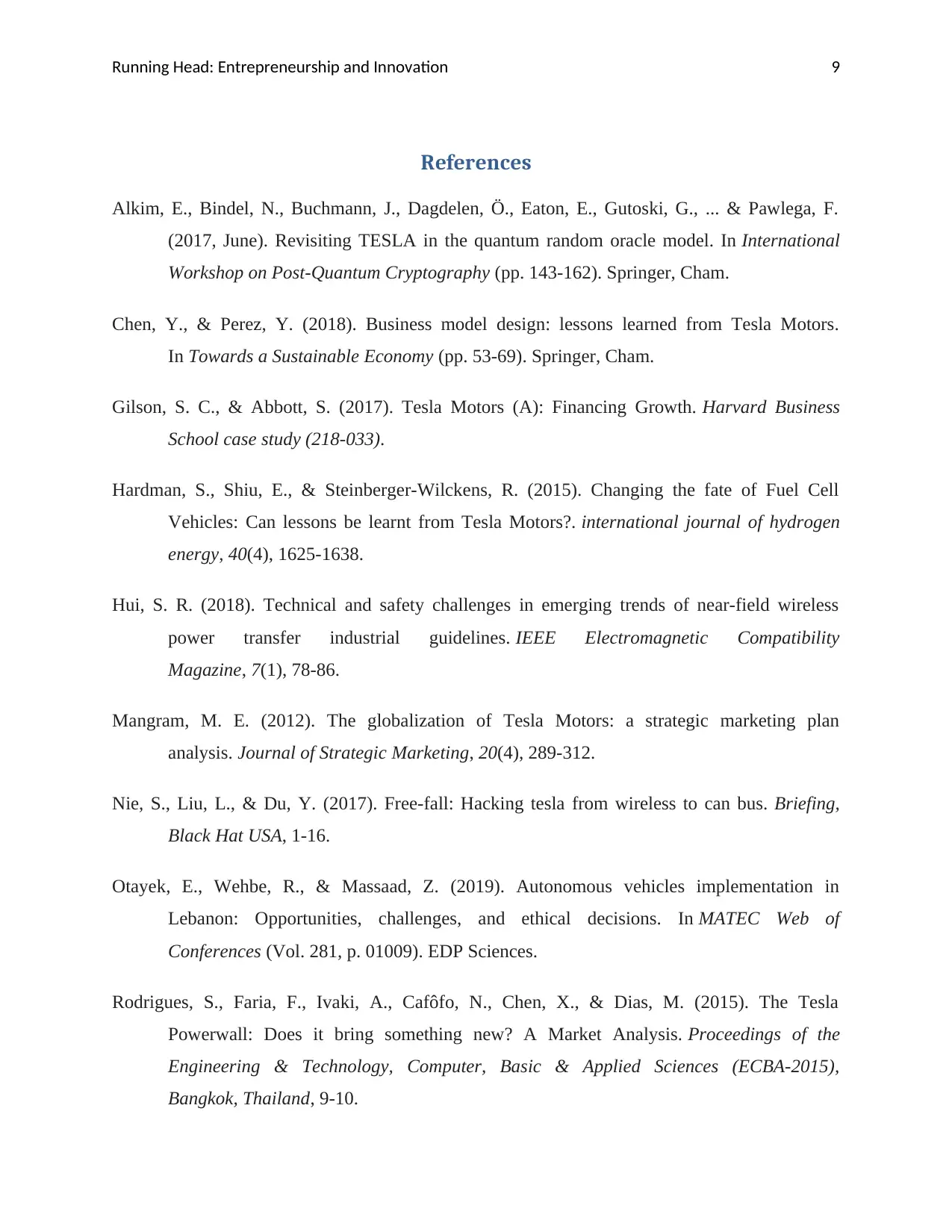
Running Head: Entrepreneurship and Innovation 9
References
Alkim, E., Bindel, N., Buchmann, J., Dagdelen, Ö., Eaton, E., Gutoski, G., ... & Pawlega, F.
(2017, June). Revisiting TESLA in the quantum random oracle model. In International
Workshop on Post-Quantum Cryptography (pp. 143-162). Springer, Cham.
Chen, Y., & Perez, Y. (2018). Business model design: lessons learned from Tesla Motors.
In Towards a Sustainable Economy (pp. 53-69). Springer, Cham.
Gilson, S. C., & Abbott, S. (2017). Tesla Motors (A): Financing Growth. Harvard Business
School case study (218-033).
Hardman, S., Shiu, E., & Steinberger-Wilckens, R. (2015). Changing the fate of Fuel Cell
Vehicles: Can lessons be learnt from Tesla Motors?. international journal of hydrogen
energy, 40(4), 1625-1638.
Hui, S. R. (2018). Technical and safety challenges in emerging trends of near-field wireless
power transfer industrial guidelines. IEEE Electromagnetic Compatibility
Magazine, 7(1), 78-86.
Mangram, M. E. (2012). The globalization of Tesla Motors: a strategic marketing plan
analysis. Journal of Strategic Marketing, 20(4), 289-312.
Nie, S., Liu, L., & Du, Y. (2017). Free-fall: Hacking tesla from wireless to can bus. Briefing,
Black Hat USA, 1-16.
Otayek, E., Wehbe, R., & Massaad, Z. (2019). Autonomous vehicles implementation in
Lebanon: Opportunities, challenges, and ethical decisions. In MATEC Web of
Conferences (Vol. 281, p. 01009). EDP Sciences.
Rodrigues, S., Faria, F., Ivaki, A., Cafôfo, N., Chen, X., & Dias, M. (2015). The Tesla
Powerwall: Does it bring something new? A Market Analysis. Proceedings of the
Engineering & Technology, Computer, Basic & Applied Sciences (ECBA-2015),
Bangkok, Thailand, 9-10.
References
Alkim, E., Bindel, N., Buchmann, J., Dagdelen, Ö., Eaton, E., Gutoski, G., ... & Pawlega, F.
(2017, June). Revisiting TESLA in the quantum random oracle model. In International
Workshop on Post-Quantum Cryptography (pp. 143-162). Springer, Cham.
Chen, Y., & Perez, Y. (2018). Business model design: lessons learned from Tesla Motors.
In Towards a Sustainable Economy (pp. 53-69). Springer, Cham.
Gilson, S. C., & Abbott, S. (2017). Tesla Motors (A): Financing Growth. Harvard Business
School case study (218-033).
Hardman, S., Shiu, E., & Steinberger-Wilckens, R. (2015). Changing the fate of Fuel Cell
Vehicles: Can lessons be learnt from Tesla Motors?. international journal of hydrogen
energy, 40(4), 1625-1638.
Hui, S. R. (2018). Technical and safety challenges in emerging trends of near-field wireless
power transfer industrial guidelines. IEEE Electromagnetic Compatibility
Magazine, 7(1), 78-86.
Mangram, M. E. (2012). The globalization of Tesla Motors: a strategic marketing plan
analysis. Journal of Strategic Marketing, 20(4), 289-312.
Nie, S., Liu, L., & Du, Y. (2017). Free-fall: Hacking tesla from wireless to can bus. Briefing,
Black Hat USA, 1-16.
Otayek, E., Wehbe, R., & Massaad, Z. (2019). Autonomous vehicles implementation in
Lebanon: Opportunities, challenges, and ethical decisions. In MATEC Web of
Conferences (Vol. 281, p. 01009). EDP Sciences.
Rodrigues, S., Faria, F., Ivaki, A., Cafôfo, N., Chen, X., & Dias, M. (2015). The Tesla
Powerwall: Does it bring something new? A Market Analysis. Proceedings of the
Engineering & Technology, Computer, Basic & Applied Sciences (ECBA-2015),
Bangkok, Thailand, 9-10.

Running Head: Entrepreneurship and Innovation 10
Roy, R. (2017). The Changing Face of Performance Improvement: Lessons Gleaned from the
Electric Car Company. Performance Improvement, 56(6), 49-50.
Stanković, R. S., Stanković, M., & Pichler, F. (2017, February). Nikola Tesla-A tribute to his
inventions. In International Conference on Computer Aided Systems Theory (pp. 66-73).
Springer, Cham.
Teece, D. J. (2018). Tesla and the Reshaping of the Auto Industry. Management and
Organization Review, 14(3), 501-512.
Wilson, S. (2017). Nikola Tesla and the science of'a successful paranoia'. Language and
Psychoanalysis, 6(7), 4-25.
Wodzyńska, J., & Czyżewski, R. (2019). Examples of financing innovative
projects. MAZOWSZE Studia Regionalne, (30), 85-102.
Roy, R. (2017). The Changing Face of Performance Improvement: Lessons Gleaned from the
Electric Car Company. Performance Improvement, 56(6), 49-50.
Stanković, R. S., Stanković, M., & Pichler, F. (2017, February). Nikola Tesla-A tribute to his
inventions. In International Conference on Computer Aided Systems Theory (pp. 66-73).
Springer, Cham.
Teece, D. J. (2018). Tesla and the Reshaping of the Auto Industry. Management and
Organization Review, 14(3), 501-512.
Wilson, S. (2017). Nikola Tesla and the science of'a successful paranoia'. Language and
Psychoanalysis, 6(7), 4-25.
Wodzyńska, J., & Czyżewski, R. (2019). Examples of financing innovative
projects. MAZOWSZE Studia Regionalne, (30), 85-102.
1 out of 10
Related Documents
Your All-in-One AI-Powered Toolkit for Academic Success.
+13062052269
info@desklib.com
Available 24*7 on WhatsApp / Email
![[object Object]](/_next/static/media/star-bottom.7253800d.svg)
Unlock your academic potential
© 2024 | Zucol Services PVT LTD | All rights reserved.





